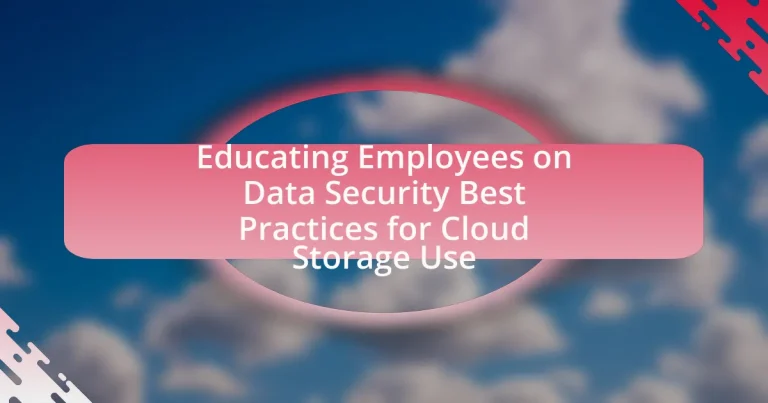The article focuses on educating employees about data security best practices for cloud storage use. It emphasizes the importance of implementing strong access controls, data encryption, regular software updates, and comprehensive employee training to mitigate risks associated with data breaches and cyberattacks. Key topics include the significance of employee awareness in preventing security incidents, the financial and reputational risks of poor data security practices, and the role of compliance with regulations like GDPR and HIPAA. Additionally, the article outlines effective strategies for training employees, including online modules, workshops, and ongoing engagement techniques to foster a culture of security within organizations.
What are Data Security Best Practices for Cloud Storage Use?
Data security best practices for cloud storage use include implementing strong access controls, encrypting data both in transit and at rest, regularly updating software, and conducting employee training on security awareness. Strong access controls, such as multi-factor authentication, help prevent unauthorized access, while encryption protects sensitive information from breaches. Regular software updates address vulnerabilities that could be exploited by attackers. Employee training ensures that staff are aware of potential threats, such as phishing attacks, and understand the importance of following security protocols. These practices collectively enhance the security posture of organizations utilizing cloud storage.
Why is it important to educate employees on data security?
Educating employees on data security is crucial because it significantly reduces the risk of data breaches and cyberattacks. Employees are often the first line of defense against security threats; their awareness and understanding of data security protocols can prevent unauthorized access and data loss. According to a report by IBM, human error is a factor in 95% of cybersecurity incidents, highlighting the importance of training employees to recognize and respond to potential threats effectively. By providing education on data security best practices, organizations can foster a culture of security awareness, ultimately protecting sensitive information and maintaining compliance with regulations.
What risks are associated with poor data security practices?
Poor data security practices expose organizations to significant risks, including data breaches, financial loss, and reputational damage. Data breaches can lead to unauthorized access to sensitive information, resulting in the theft of personal data, intellectual property, or trade secrets. According to the 2021 IBM Cost of a Data Breach Report, the average cost of a data breach is $4.24 million, highlighting the financial implications of inadequate security measures. Additionally, organizations may face legal consequences and regulatory fines for failing to protect data, as seen in cases involving GDPR violations. Reputational damage can erode customer trust and loyalty, further impacting an organization’s bottom line. Therefore, the risks associated with poor data security practices are multifaceted and can have long-lasting effects on an organization’s viability and success.
How can employee education mitigate these risks?
Employee education can mitigate risks associated with data security in cloud storage by equipping staff with the knowledge and skills necessary to recognize and respond to potential threats. Training programs that focus on data security best practices, such as identifying phishing attempts, using strong passwords, and understanding data encryption, significantly reduce the likelihood of human error, which is a leading cause of data breaches. According to a study by the Ponemon Institute, organizations that implement comprehensive security awareness training can reduce the risk of a data breach by up to 70%. This demonstrates that informed employees are less likely to engage in risky behaviors that could compromise sensitive information stored in the cloud.
What key principles should employees understand about data security?
Employees should understand that data security is fundamentally about protecting sensitive information from unauthorized access and breaches. Key principles include the importance of strong passwords, regular software updates, and awareness of phishing attacks. Strong passwords should be complex and unique, as studies show that 81% of data breaches are linked to weak or stolen passwords. Regular software updates are crucial because they patch vulnerabilities; for instance, the 2017 Equifax breach was largely due to unpatched software. Lastly, employees must recognize phishing attacks, which accounted for 90% of data breaches in 2020, emphasizing the need for vigilance in identifying suspicious emails and links.
What is the significance of strong passwords and authentication?
Strong passwords and authentication are crucial for protecting sensitive data from unauthorized access. They serve as the first line of defense against cyber threats, significantly reducing the risk of data breaches. According to a report by Verizon, 81% of hacking-related breaches leverage stolen or weak passwords, highlighting the importance of robust password policies. Strong passwords, which typically include a mix of letters, numbers, and symbols, make it more difficult for attackers to gain access. Additionally, multi-factor authentication (MFA) adds an extra layer of security by requiring users to provide two or more verification factors, further decreasing the likelihood of unauthorized access. This combination of strong passwords and effective authentication methods is essential for safeguarding cloud storage and sensitive information.
How does data encryption protect sensitive information?
Data encryption protects sensitive information by converting it into a coded format that can only be read by authorized users with the correct decryption key. This process ensures that even if data is intercepted during transmission or accessed without permission, it remains unreadable and secure. For instance, the Advanced Encryption Standard (AES) is widely used and recognized for its effectiveness in safeguarding data, as it employs complex algorithms that make unauthorized access extremely difficult.
What role does compliance play in data security education?
Compliance plays a critical role in data security education by establishing the legal and regulatory frameworks that organizations must follow to protect sensitive information. These frameworks, such as GDPR and HIPAA, mandate specific training and awareness programs for employees, ensuring they understand their responsibilities regarding data handling and security practices. Compliance requirements often include regular assessments and updates to training materials, which reinforce the importance of data security and help mitigate risks associated with data breaches. By adhering to these compliance standards, organizations not only protect their data but also foster a culture of security awareness among employees, ultimately enhancing overall data security posture.
Which regulations should employees be aware of?
Employees should be aware of regulations such as the General Data Protection Regulation (GDPR), the Health Insurance Portability and Accountability Act (HIPAA), and the Federal Information Security Management Act (FISMA). GDPR mandates strict data protection and privacy for individuals within the European Union, requiring organizations to implement robust data security measures. HIPAA establishes standards for the protection of health information, necessitating secure handling of sensitive patient data. FISMA requires federal agencies to secure information systems, emphasizing the importance of risk management and security controls. Understanding these regulations is crucial for employees to ensure compliance and protect sensitive information in cloud storage environments.
How can compliance training enhance data security awareness?
Compliance training enhances data security awareness by equipping employees with the knowledge of regulations, policies, and best practices related to data protection. This training informs staff about potential threats, such as phishing and data breaches, and emphasizes the importance of safeguarding sensitive information. Research indicates that organizations with regular compliance training experience a 70% reduction in security incidents, demonstrating its effectiveness in fostering a culture of security awareness. By understanding their roles and responsibilities, employees become more vigilant and proactive in identifying and mitigating risks associated with data security.
How can organizations effectively educate employees on data security?
Organizations can effectively educate employees on data security by implementing comprehensive training programs that include regular workshops, interactive e-learning modules, and real-world simulations. These programs should cover essential topics such as password management, phishing awareness, and secure data handling practices. Research indicates that organizations with ongoing security training see a 70% reduction in security incidents, highlighting the importance of continuous education. Additionally, incorporating assessments and feedback mechanisms can reinforce learning and ensure that employees understand and apply data security best practices in their daily tasks.
What tools and resources are available for training employees?
Various tools and resources are available for training employees on data security best practices for cloud storage use. These include online training platforms such as Coursera and LinkedIn Learning, which offer courses specifically focused on data security and cloud storage. Additionally, organizations can utilize Learning Management Systems (LMS) like Moodle or TalentLMS to create customized training modules tailored to their specific security policies.
Moreover, interactive resources such as webinars, workshops, and simulation exercises can enhance employee engagement and understanding of data security protocols. Industry-specific guidelines from organizations like the National Institute of Standards and Technology (NIST) provide frameworks and best practices that can be integrated into training programs.
Furthermore, regular security awareness campaigns and newsletters can reinforce training and keep employees updated on the latest threats and security measures. These resources collectively contribute to a comprehensive training strategy that ensures employees are well-informed about data security in cloud storage environments.
How can online training modules be utilized for effective learning?
Online training modules can be utilized for effective learning by providing structured, interactive content that engages employees and reinforces knowledge retention. These modules often incorporate multimedia elements such as videos, quizzes, and simulations, which cater to various learning styles and enhance understanding of complex topics like data security best practices for cloud storage. Research indicates that interactive learning can improve retention rates by up to 75%, compared to traditional lecture-based methods. Additionally, online training allows for flexible scheduling, enabling employees to learn at their own pace, which has been shown to increase completion rates and overall satisfaction with the training process.
What role do workshops and hands-on training play in education?
Workshops and hands-on training play a crucial role in education by providing practical experience that enhances theoretical knowledge. These interactive learning environments allow participants to engage directly with the material, facilitating deeper understanding and retention of concepts. For instance, studies show that experiential learning can improve knowledge retention by up to 75% compared to traditional lecture-based methods. This approach is particularly effective in fields like data security, where real-world application of best practices for cloud storage is essential for effective learning and implementation.
What are common challenges in educating employees on data security?
Common challenges in educating employees on data security include lack of awareness, varying levels of technical expertise, and resistance to change. Employees often do not fully understand the importance of data security, which can lead to negligence in following protocols. Additionally, the diverse skill sets among employees create disparities in comprehension, making it difficult to implement a one-size-fits-all training approach. Resistance to change arises when employees perceive security measures as cumbersome or unnecessary, hindering their willingness to adopt new practices. These challenges are supported by studies indicating that 60% of data breaches are attributed to human error, highlighting the critical need for effective education and training programs.
How can organizations overcome resistance to training?
Organizations can overcome resistance to training by actively involving employees in the training process and clearly communicating the benefits of the training. Engaging employees through participatory methods, such as workshops or feedback sessions, fosters a sense of ownership and reduces apprehension. Additionally, demonstrating how the training directly impacts their roles and enhances their skills can motivate participation. Research indicates that when employees understand the relevance of training to their job performance, their willingness to engage increases significantly. For instance, a study by the Association for Talent Development found that organizations that effectively communicate the purpose and benefits of training see a 34% increase in employee engagement in training programs.
What strategies can be implemented to ensure ongoing engagement?
To ensure ongoing engagement in educating employees on data security best practices for cloud storage use, organizations can implement regular training sessions and interactive workshops. These strategies foster a continuous learning environment, allowing employees to stay updated on evolving security threats and best practices. Research indicates that organizations that conduct regular training see a 70% increase in employee awareness of security protocols, which directly correlates with reduced incidents of data breaches. Additionally, incorporating gamification elements into training can enhance participation and retention, as studies show that gamified learning experiences can improve engagement by up to 50%.
What practical tips can enhance data security practices among employees?
To enhance data security practices among employees, organizations should implement regular training sessions focused on identifying phishing attempts and understanding secure password management. Research indicates that 90% of data breaches are caused by human error, highlighting the importance of education in mitigating risks. Additionally, enforcing multi-factor authentication can significantly reduce unauthorized access, as it adds an extra layer of security beyond just passwords. Regularly updating software and systems also plays a crucial role, as outdated programs are often targeted by cybercriminals. By fostering a culture of security awareness and accountability, organizations can effectively strengthen their data protection measures.
How can regular updates and reminders improve security awareness?
Regular updates and reminders significantly enhance security awareness by keeping employees informed about the latest threats and best practices. This continuous flow of information ensures that employees remain vigilant and knowledgeable about evolving security risks, which is crucial in a rapidly changing digital landscape. Research indicates that organizations implementing regular training and reminders experience a 70% reduction in security incidents, as employees are more likely to recognize and respond appropriately to potential threats. By reinforcing security protocols through consistent communication, organizations can foster a culture of security mindfulness, ultimately leading to better protection of sensitive data in cloud storage environments.
What role does a culture of security play in an organization?
A culture of security plays a critical role in an organization by fostering an environment where security is prioritized and integrated into daily operations. This culture encourages employees to adopt best practices for data security, particularly in the context of cloud storage, thereby reducing the risk of data breaches and enhancing overall organizational resilience. Research indicates that organizations with a strong security culture experience 50% fewer security incidents, as employees are more vigilant and proactive in identifying potential threats.


